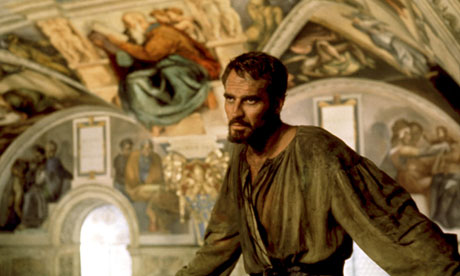
The Agony and the Ecstasy (1965)
Director: Carol Reed
Entertainment grade: D+
History grade: B–
During his own lifetime, sculptor, architect and painter Michelangelo Buonarroti was considered to be the greatest artist in Europe.
Facts
The film begins with a formal 12-minute history lesson on Michelangelo's life and work. It includes a tip for American audiences at the time of the film's release that the sublime Pietà of St Peter's was then on display at the New York World's Fair. This piece of information now does little but give historians conniptions at the thought someone might have dropped it on the way. The intent to inform is laudable, but a fictional film should really be able to convey its subject without a lecture – and this lecture sets a regrettably pompous tone that infects the rest of the movie. Just as you're wondering whether you've started watching a documentary by mistake, Rex Harrison rides onscreen as Pope Julius II and gets on with conquering cities, prancing about in white robes and graciously throwing coins at poor people. Phew.
Art
Julius takes Michelangelo (Charlton Heston) to a chapel. "As you know, it was built by my uncle, Pope Sixtus," he says. "That is why it is called the Sistine." Seems like the lecture isn't over yet. "It has no more architecture than a cow barn," grumbles Michelangelo. "You will correct the clumsiness of my uncle's architects," says Julius. "Your commission is to decorate the ceiling." The screenplay goes heavy on the dialogue, light on the action. After 45 minutes of nothing much happening, there's finally some drama when Michelangelo gets drunk and decides his first set of frescoes are duff. He sloshes red paint all over them and flounces off. "He will paint it or he will hang!" declares the pope. The film is right that the pope and Michelangelo had a fraught relationship, and that the artist considered his original commission too limiting.
Inspiration
Wandering in the marble quarries of Carrara, Michelangelo ascends a mountain and sees in the clouds the faces of God and Adam, which he will later paint on the Sistine ceiling. Heston played Moses in The Ten Commandments the same year this film came out; the parallels aren't subtle. "It is a cheesy, overblown scene and a brazen inversion of an actual event, Michelangelo's vision of a giant monument on an Apuan mountaintop", wrote Eric Scigliano in his book Michelangelo's Mountain. The film breaks for an intermission and grandiose entr'acte music. An intermission isn't usually necessary midway through a two-hour movie, but this one is quite boring – so you might appreciate the opportunity to do something else for a bit.
Sex
Michelangelo has a chaste affection for Contessina de' Medici (Diane Cilento), daughter of Lorenzo the Magnificent. "Is it another woman?" she asks, when he refuses to make it less chaste. "No," he mumbles, standing sheepishly in front of a sketch of a naked man. That's as far as the film goes, concluding that Michelangelo's genius was so all-consuming that he had no energy left for love or sex. "What runs in Michelangelo's veins is not blood; it's paint," says the pope.
More sex
In fact, the real Michelangelo's love poems, written mostly to young men such as Tommaso dei Cavalieri, are hot stuff. Moreover, anyone viewing some of his depictions of purportedly female subjects, such as Night from the tomb of Giuliano de' Medici, might reasonably conclude that the artist spent more time looking at naked men than naked women. They'd be correct. Female figures such as the Libyan Sibyl on the Sistine ceiling are known to have been based on studies of male anatomy. What this film desperately needs to liven it up are the real Michelangelo's passions, but Hollywood might not have considered these suitable for general audiences in 1965.
Verdict
The Agony and the Ecstasy is reasonably accurate so far as it goes, but the story of Michelangelo would be more interesting – and, arguably, truer to the spirit of the man and his work – if it were told with a lot more humour and a lot less prudishness.

